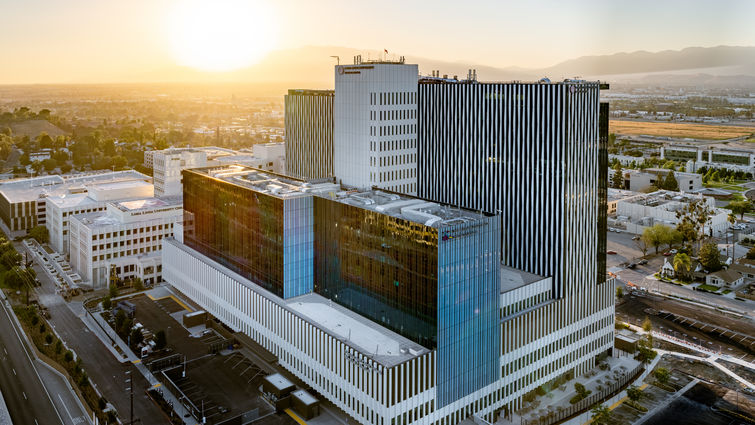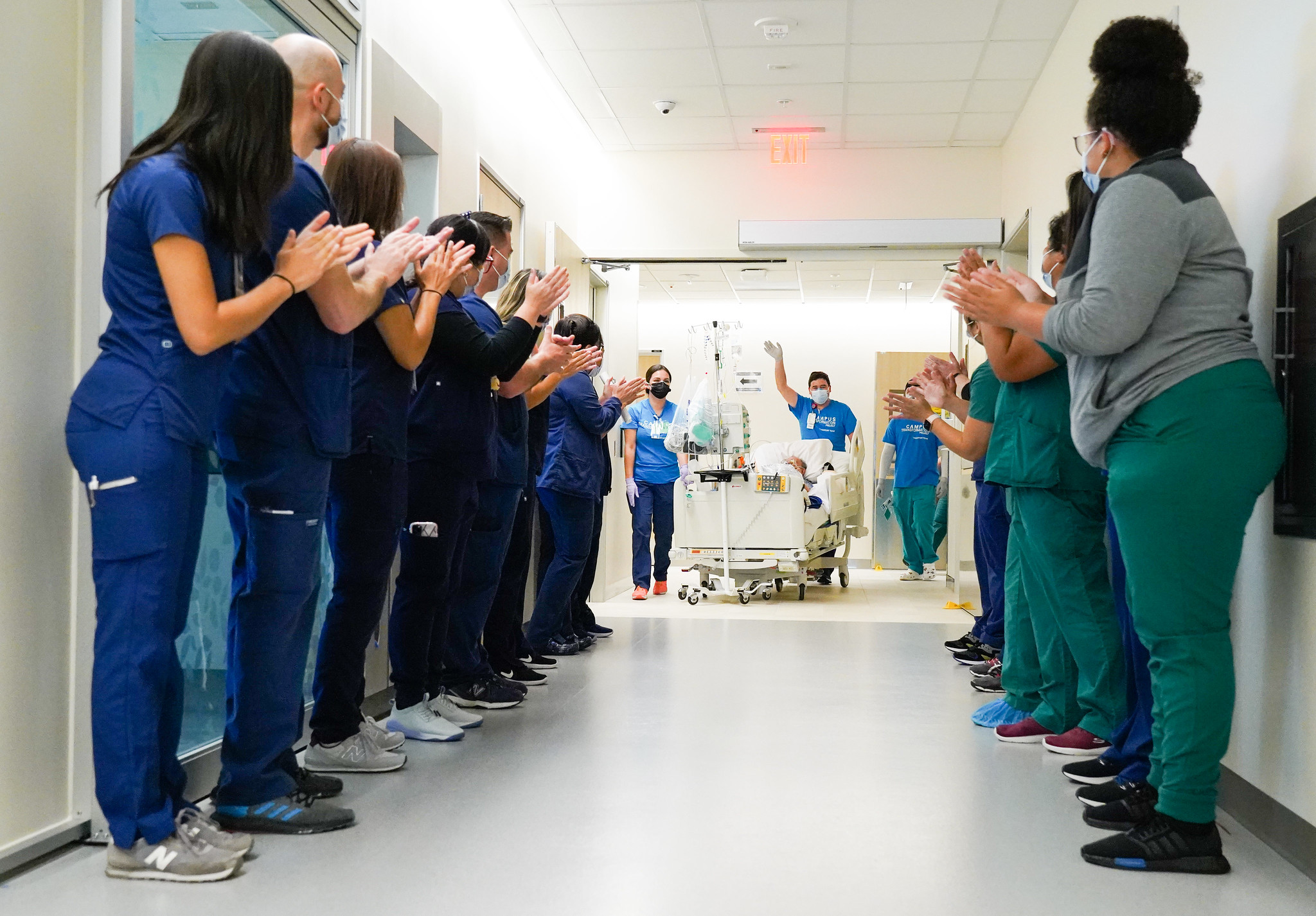
Elevated photo of Dennis and Carol Troesh Medical Campus.
The International Heart Institute moved into the Dennis and Carol Troesh Medical Campus earlier this month, a transition that kicked off an enhanced cardiac patient experience.
The changeover enabled a three-fold expansion of the cardiac diagnostic department, private patient rooms, and state-of-the-art equipment for diagnostics and procedures.
 “Our move into the new hospital enables a significant increase in capacity and reflects our continued commitment to meeting cardiac patients’ needs for timely, high-quality care,” says cardiologist Nirav Mamdani, MD.
“Our move into the new hospital enables a significant increase in capacity and reflects our continued commitment to meeting cardiac patients’ needs for timely, high-quality care,” says cardiologist Nirav Mamdani, MD.
Timely access to care is essential for cardiac patients who often require procedures that will improve their quality of life and longevity, Mamdani says. Patients who wait too long for a procedure may need to undergo temporizing measures, experience multiple episodes of hospitalizations, or spend hours in emergency department.
“We hope to make these procedures available in a much shorter timeframe than what has been possible in the past.” Mamdani highlights how some of the newest additions and amenities honor patients’ needs for on-demand access to safe, quality care.
Expanded diagnostics department
An increase in the number of available, spacious rooms for diagnostic testing equips care teams to swiftly and efficiently perform diagnostic testing — cardiac echocardiograms, stress tests, etc. — for more patients. Eight brand new echocardiography laboratories will permit care teams to complete over 60 procedures daily, Mamdani says. Moreover, he says an extra area in the new hospital remains reserved for further expansion over time as demand for diagnostic testing continues to grow.
More catheterization laboratories
Beyond increasing diagnostic testing capacity, the hospital's newfound space also accommodated the construction of six catheterization laboratories (cath labs) that will provide life-changing cardiac procedures to more patients in less time. Come September, more patients can access structural heart and electrophysiology procedures, including transcatheter aortic valve replacement (TAVR), transcatheter mitral valve repair (TMVR), Watchman procedure, and device placements.
The International Heart Institute anticipated this increased capacity and ability to offer procedures to more patients, Mamdani says. So it has boosted recruitment efforts over the past two years, securing adequate staffing of physicians and technicians to match the expected increase in volume.
Hybrid operating rooms
Keeping pace with the cutting edge of cardiac procedures, LLU has built a hybrid cardiothoracic (CT) surgery and cath lab room, allowing both kinds of strategies to co-occur in the same room. Specific cardiac procedures or complex anatomies require a mixture of both endovascular, or non-invasive, intervention and open-chest surgery.
In these cases, the hybrid CT-cath lab room expedites the procedure flow smoothly without ever requiring the patient to move, Mamdani says. With this hybrid OR, LLU is well-positioned to keep up with the increasingly fast-growing hybrid approach to surgeries, he says.
Another hybrid OR combines a cardiology room with a peripheral vascular intervention room, where multi-purpose equipment serves both cardiac surgeries and vascular interventions to treat areas like the aorta or corroded arteries.
Biplane X-ray equipment in the hybrid rooms can capture images of the body from two different angles simultaneously and produce the resulting images in higher resolution. These factors decrease patients’ exposure to radiation and reduce the need for contrast dye to decipher the images, thus posing less of a risk of kidney damage, Mandami says.
Pre- and post-operation units
For patients awaiting or recovering directly after a procedure, the pre-and post-operation (op) units are a vital asset to timely care. These units function essentially as holding areas to accommodate patients swiftly and reduce any delay in care as much as possible, Mamdani says.
For instance, if a patient visits the emergency department (ED) and requires a procedure but a cardiac bed is not yet available, they will move immediately into a pre-op unit to undergo preparation for their operation. After the procedure, patients will also recover in the post-op unit before moving into their designated room on the 10th floor for overnight observation.
“These pre-and post-op units enable our care teams to offer crucial cardiac procedures without delay so patients need not wait, spend additional time in the ER, or plan to come in one day before surgery just to secure a bed.”
Same-day care observation units
Recognizing that not all patients require overnight stays to have their care needs met, Mamdani says the space vacated on the eighth floor of the old hospital building during the move has since transformed into a 33-bed observation unit — explicitly built to accommodate such patients.
This addition will limit the time patients with certain cardiac conditions or events spend in an ER and direct them to the cardiac observation unit for same-day care. Patients that present with low chest pain or minor worsening of congestive heart failure symptoms, for example, may not require intensive testing. Instead, these cases may call for non-invasive testing or receiving dosages of IV diuretics for a few hours. Patients access these services quickly in the observation unit designed to accommodate these needs and, once stable, will be able to return home without spending a night at the hospital.
10th-floor hospital stays
For the cardiac patients who stay longer-term, single, spacious rooms with city views are available on the 10th floor. The rooms grant patients personal privacy, the liberty to receive visitors on their terms, and to recover peacefully in the comfort of their own space.
 “Privacy is important for every human being, and especially when in a hospital during a more vulnerable time in their lives,” Mamdani says. “These single rooms are key to patients’ well-being and healing process.”
“Privacy is important for every human being, and especially when in a hospital during a more vulnerable time in their lives,” Mamdani says. “These single rooms are key to patients’ well-being and healing process.”
Patients seeking care at the Dennis and Carol Troesh Medical Campus for any cardiac reasons will benefit from its resources and well-equipped, expert care teams for decades to come, Mamdani says.
To learn more about all of the resources offered to cardiac patients at the International Heart Institute, visit https://lluh.org/heart-vascular or call 800-468-5432.
